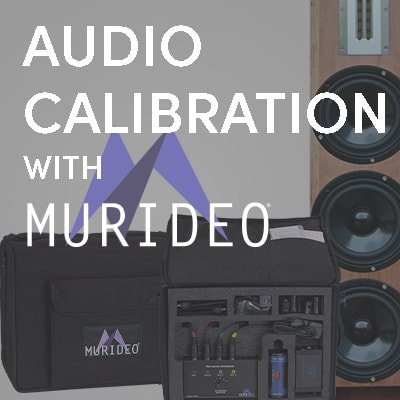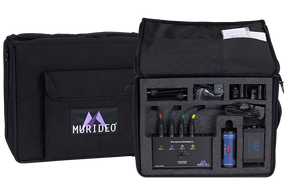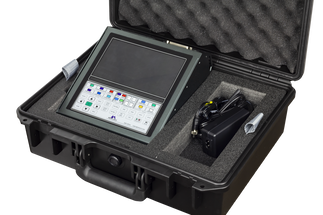 Whether it’s 2 channel or a fully immersive sound system, audio is one of our favorite topics at Murideo. One of the most significant misunderstood aspects of audio is how vital the room itself is and its impact on an audio system’s overall sound quality. This can present a problem with integrators, especially when a system doesn’t meet theirs or the client’s expectations. Maybe there isn’t enough (or too much) bass. Maybe cymbals from a drum kit are lacking clarity during an epic movie scene or a favorite album. Maybe dialogue in a movie or the vocals of a live performance are muffled or too quiet. So the question now is, how can we make it better? The #1 issue is, you can’t fix what you don’t measure. So how do you measure an audio system? We introduce to you the Murideo Audio Calibration Kit. The kit consists of 4 high-quality Dayton EEM-6 microphones, our own Murideo multiplexer, an iAudioInterface2 that will allow you to control everything with a PC or iOS device, high-quality cables to connect the mics, a carrying case, and more! Using this kit will tell you everything you need to know about a room or any other acoustic environment so you can make informed decisions on speaker placement, audio levels, and equalization, just to name a few.  As an integrator, the last thing you want is an unhappy customer due to an underwhelming system. Use this kit to ensure that all of your customers are happy with their audio system and increase your revenue stream. Video calibrators often overlook audio, and adding audio calibration is a great way to expand on your service offerings and generate more revenue. For more information on the Murideo audio calibration kit, visit the MU-TEST-AUDIO webpage or send us an email at [email protected]. We are also available for a live chat at Murideo.com, or you can speak with a Murideo representative at 605-330-8491.
0 Comments
 This month our featured partner is Kevin Miller. Kevin provides professional calibration services and technical consulting in the New York tri-state area and we are proud to call him a customer and a friend! Check out what he had to say about his experiences in the industry and with ISF. I was involved in the creation of the ISF with Joel Silver dating back to the spring of 1993 when working at The Perfect Vision as the Publisher and CEO. The idea that Joel so eloquently described was spawned over cocktails one evening at an InfoComm show in New Orleans. A little over a year later, in February of 1994, Joel launched his company with the first ever ISF seminar at the Waldorf Astoria hotel in New York City. I was at that seminar as a student with my Philips color analyzer in hand. I started my company, ISFTV, in February of 2001. Later that year, I co-instructed a seminar with Joel that followed the CEDIA show in Indianapolis. Day two of the seminar, as fate would have it, was on 9/11/2001. We had a very large group of nearly 60 students who were all quite shaken by the morning’s events. Our great friend Stu Kobak, who ran a DVD review web site of his own called Filmsondisc.com, got Joel on the phone and encouraged him to have us finish that seminar even in the face of the horrific events of that day. We did persevere and got the class to the finish line. Following that 2001 seminar, I spent many years co-instructing ISF seminars with Joel all over North America, which was a great learning experience. Joel helped launch my company as he has done for many small businesses all over the world. I am proud to have been a part of the creation of the Imaging Science Foundation, and continue to work closely with Joel and a number of talented technicians all over the country, furthering the goal of delivering the artist’s (Director’s) intent to consumer’s television screens. I have also been heavily involved for many years on the professional side of our industry, now supporting over 60 Post Production facilities with my professional calibration services and technical consulting in the New York tri-state area. I have also been providing technical and product development consulting to TV and video source manufacturers since 2003. Thank you Kevin for sharing your experiences with us! Metadata (met·a·da·ta): A set of data that describes and gives information about other data How could that little word (metadata) cause havoc for so many Audio/Video manufacturers and integrators trying to line up the audio and video signal? Why? Because our industry has gone beyond traditional 2 channel, or 6 channel, or even 8 channels of audio. Dolby Atmos and DTS HD are perfect examples of audio signals that rely on metadata to distribute audio through many channels. This invisible code runs alongside the audio signal that tells your audio products to distribute the specific sound to a specific channel; this code is metadata. Why would metadata cause lip sync issues? When dealing with metadata, it takes time to decode the signal, and this can cause delays in your audio delivery. You may find your audio signal is coming in after your video. This is a new problem as integrators have always had the opposite problem, audio coming before the video and needing to delay the audio to line it up. How many of the tools you use to line up that audio have a video delay option? Almost none!
Testing your products to see how they react with different types of audio and video combinations will allow you to deliver a superior installation or product to your customer. The Murideo method enables you to test these signals via HDMI, ARC, or even the HDMI 2.1 specification feature eARC.
The Murideo SEVEN Generator is a scientifically accurate audio video testing device that allows you to select thousands of combinations of signals, including Dolby Atmos audio and HDR resolutions. As you test your product with various signals, you can measure the lip sync down to the millisecond, allowing you to make adjustments as needed. If you would like more information on the SEVEN Generator, give us a call at 605-330-8491 or email us at [email protected]. |
Third Party Reviews & Articles
SIX-G Generator
Archives
July 2024
Categories |
|
|
© Copyright 2015-2023
Home Contact Us About Us Careers Warranty 2222 E 52nd Street North, Suite 101, Sioux Falls SD 57104 +1 605-330-8491 [email protected] |


 RSS Feed
RSS Feed